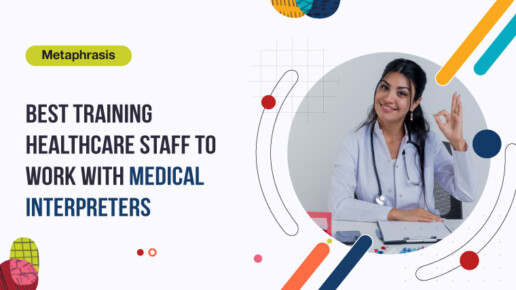Best Training Healthcare Staff to Work with Medical Interpreters
In the rapidly evolving landscape of healthcare, effective communication is at the core of providing quality patient care. One significant aspect that often faces challenges is overcoming language barriers, a hurdle that can compromise patient safety and satisfaction. In this blog, we delve into the critical need for training healthcare staff to work seamlessly with medical interpreters, ensuring that language differences don’t hinder the delivery of optimal medical care.
Introduction
In the diverse and multicultural world of healthcare, the ability to communicate across language barriers is paramount. As the global population becomes more interconnected, healthcare professionals encounter patients from a multitude of linguistic backgrounds. The reliance on medical interpreters has become indispensable to bridge these communication gaps. However, the effectiveness of these interactions largely depends on the preparedness and training of healthcare staff.
Understanding the Role of Medical Interpreters
Medical interpreters serve as linguistic bridges, facilitating communication between healthcare providers and patients with limited English proficiency or non-English-speaking backgrounds. Their role extends beyond mere translation; we play a pivotal part in ensuring accurate conveyance of medical information, treatment plans, and patient concerns.
Challenges in Healthcare Communication
Language barriers pose significant challenges in healthcare settings. Miscommunication can lead to misunderstandings regarding medical history, symptoms, and treatment options, jeopardizing patient safety. Addressing these challenges requires a proactive approach to equip healthcare staff with the necessary skills to navigate diverse linguistic landscapes.
Benefits of Training Healthcare Staff
Investing in training programs for healthcare staff yields numerous benefits. Cultural competence is heightened, leading to a more inclusive and patient-centered care environment. Moreover, trained staff contributes to increased patient satisfaction, fostering a sense of trust and rapport between healthcare providers and their diverse patient population.
Key Components of Training Programs
Effective training programs encompass various components. Language proficiency assessments help identifies areas of improvement, while cross-cultural communication training builds awareness and sensitivity. Real-life scenario simulations provide practical experience, preparing healthcare professionals for the complexities of diverse patient interactions.
Incorporating Technology in Training
The integration of technology further enhances training initiatives. Language translation tools can be valuable assets in on-the-spot communication, and online modules offer flexibility for staff members to engage in continuous learning. Embracing technology ensures that training remains dynamic and relevant to evolving healthcare landscapes.
Success Stories: Hospitals Leading the Way
Several hospitals have set exemplary standards in training healthcare staff to collaborate seamlessly with medical interpreters. Case studies and success stories illustrate the positive impact of such initiatives, showcasing improved patient outcomes and elevated standards of care.
Addressing Resistance and Overcoming Challenges
While recognizing the potential resistance to training, it’s crucial to address concerns and highlight the positive outcomes that follow. Strategies for overcoming challenges should be integrated into training programs, ensuring a smooth transition and acceptance among healthcare staff.
Measuring the Impact of Training Programs
To gauge the effectiveness of training programs, methods of evaluation must be in place. Assessing improvements in communication, patient satisfaction, and overall healthcare outcomes provides valuable insights into the impact of interpreter training initiatives.
Ensuring Compliance and Standards
Adhering to industry standards and legal guidelines is imperative in medical interpreter training. Establishing and maintaining compliance ensures ethical practices and upholds the integrity of healthcare interactions involving interpreters.
Tailoring Training for Different Healthcare Settings
Recognizing the diverse nature of healthcare settings, training programs should be tailored to meet the specific needs of hospitals, clinics, and other medical environments. Specialized training ensures that healthcare staff is equipped to navigate the unique challenges of their respective workplaces.
Continuous Professional Development
The commitment to continuous learning is fundamental in healthcare. Encouraging ongoing education for healthcare staff ensures that language proficiency remains sharp, and professionals stay abreast of evolving medical terminology and communication strategies.
Collaboration between Healthcare Staff and Interpreters
Effective collaboration between healthcare staff and interpreters is key to successful patient outcomes. Establishing clear communication channels, fostering teamwork, and recognizing the shared responsibility for patient-centered care create a harmonious working relationship.
Future Trends in Medical Interpreter Training
Looking ahead, the landscape of medical interpreter training is poised for advancements. Emerging technologies and innovative methodologies will play a pivotal role in shaping the future of communication in healthcare. Anticipating these trends allows for proactive preparation and adaptation in training programs.
Conclusion
In conclusion, the importance of training healthcare staff to work seamlessly with medical interpreters cannot be overstated. It is a cornerstone in delivering patient-centered care in diverse communities. The investment in training pays dividends in improved communication, patient satisfaction, and ultimately, better healthcare outcomes.

